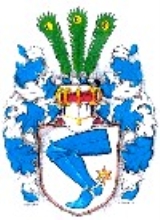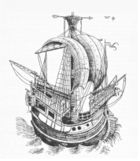
Skanke
Encyclopedia
Skanke is the name of several Norwegian families.
The name was not generally used in Middle Ages, it is a later retrospectively constructed surname for families who had their crest depicting shank, or leg
.
Later Skankes, not necessarily attested descendants of alleged medieval Skankes, have brought forward an allegation that the family descends from Manx monarchs (who lost their kingdom as result of the Treaty of Perth
and the 1275 loss of the Battle of Ronaldsway
), citing the partial similitude of figures in crest (triskelion
in Manx, and shank or leg in theirs).
was an unstable creation, often shook by struggles between the Danish and Swedish factions within the Kalmar Union. These conditions would lead the family into battle, with relatives ending up on opposing sides in a war of succession.
In 1452, knight Ørian Karlson Skanke from Jemtland is mentioned as agent of Charles VIII of Sweden
. Orjan was sent to conquer Trondheim, the ancient centre of Norway's kings. Control of this vital city would have greatly strengthened Charles' claim to the throne.
The answer from the Danish side came quickly with knight Ørian's own relatives, Olav Nilsson Skanke and his brother Peder, marching up from the south and pushing Ørian out of Trondheim. The same thing happened all over again in 1453 with Ørian seizing Trondheim and Olav and Peder driving him out once more. This second battle finally concluded the conflict over succession and ended the battles between knights of the Skanke family.
The pro-Danish side, led by the knight Olav Nilsson and his brother and fellow knight, Peder, came out on top in this struggle. The two brothers belonged to pro-Danish Norwegian forces which repeatedly defeated the Swedish forces of Charles VIII
in the area around Trondheim
in Mid-Norway. After their participation in the fighting the brothers got high ranking positions in the administration of Norway, Olav becoming the head man in Bergen.
Olav Nilsson Skanke
 Only a few years after becoming the main royal official in Bergen Olav lost his position due a conflict with the Hanseatic League
Only a few years after becoming the main royal official in Bergen Olav lost his position due a conflict with the Hanseatic League
. The League pressured the Danish king into firing Olav after he had made attempts at reducing their autonomous status in the city. In response to this Olav carried out a prolonged private war of piracy
and raiding
against both the League and Sweden, in the end forcing the Danish king into restoring his former position. After returning to Bergen, however, Olav was murdered by the League's men, together with his young son and his brother Peder, as well as the bishop of Bergen and many monks in the city's main church. After these murders the family, led by Olav's widow Elisabeth and her now fatherless children, continued to fiercely battle the League through piracy until receiving compensation and restoration of status some years later.
There no evidence beyond guesswork to link any of these later families genealogically with medieval noblemen with Shanks escutcheon.
Recent a today Skankes have a family association, which has encouraged genealogical and prosopographical research.
Amongst the sources the Skanke Association relies on, are the writings of George Vaughan Chichester Young, O.B.E., who wrote more historical books about the Isle of Man than anyone else, living or dead. One Young O.B:E. quote that supports the Skanke claims is found in his work "A Brief History of the Isle of Man":
See also: Skanke Family Association
The name was not generally used in Middle Ages, it is a later retrospectively constructed surname for families who had their crest depicting shank, or leg
Human leg
The human leg is the entire lower extremity or limb of the human body, including the foot, thigh and even the hip or gluteal region; however, the precise definition in human anatomy refers only to the section of the lower limb extending from the knee to the ankle.Legs are used for standing,...
.
Later Skankes, not necessarily attested descendants of alleged medieval Skankes, have brought forward an allegation that the family descends from Manx monarchs (who lost their kingdom as result of the Treaty of Perth
Treaty of Perth
The Treaty of Perth, 1266, ended military conflict between Norway, under King Magnus VI of Norway, and Scotland, under King Alexander III, over the sovereignty of the Hebrides and the Isle of Man....
and the 1275 loss of the Battle of Ronaldsway
Battle of Ronaldsway
The Battle of Ronaldsway took place in 1275 at Ronaldsway in the southern part of the Isle of Man between a Scottish army and the Manx. The battle crushed the final attempt by the Manx to re-establish the Norse Sudreyar dynasty...
), citing the partial similitude of figures in crest (triskelion
Triskelion
A triskelion or triskele is a motif consisting of three interlocked spirals, or three bent human legs, or any similar symbol with three protrusions and a threefold rotational symmetry. Both words are from Greek or , "three-legged", from prefix "τρι-" , "three times" + "σκέλος" , "leg"...
in Manx, and shank or leg in theirs).
Skankes opposing each other
The Kalmar UnionKalmar Union
The Kalmar Union is a historiographical term meaning a series of personal unions that united the three kingdoms of Denmark, Norway , and Sweden under a single monarch, though intermittently and with a population...
was an unstable creation, often shook by struggles between the Danish and Swedish factions within the Kalmar Union. These conditions would lead the family into battle, with relatives ending up on opposing sides in a war of succession.
In 1452, knight Ørian Karlson Skanke from Jemtland is mentioned as agent of Charles VIII of Sweden
Charles VIII of Sweden
Charles VIII of Sweden , Charles I of Norway, also Carl, , was king of Sweden and king of Norway ....
. Orjan was sent to conquer Trondheim, the ancient centre of Norway's kings. Control of this vital city would have greatly strengthened Charles' claim to the throne.
The answer from the Danish side came quickly with knight Ørian's own relatives, Olav Nilsson Skanke and his brother Peder, marching up from the south and pushing Ørian out of Trondheim. The same thing happened all over again in 1453 with Ørian seizing Trondheim and Olav and Peder driving him out once more. This second battle finally concluded the conflict over succession and ended the battles between knights of the Skanke family.
The pro-Danish side, led by the knight Olav Nilsson and his brother and fellow knight, Peder, came out on top in this struggle. The two brothers belonged to pro-Danish Norwegian forces which repeatedly defeated the Swedish forces of Charles VIII
Charles VIII of Sweden
Charles VIII of Sweden , Charles I of Norway, also Carl, , was king of Sweden and king of Norway ....
in the area around Trondheim
Trondheim
Trondheim , historically, Nidaros and Trondhjem, is a city and municipality in Sør-Trøndelag county, Norway. With a population of 173,486, it is the third most populous municipality and city in the country, although the fourth largest metropolitan area. It is the administrative centre of...
in Mid-Norway. After their participation in the fighting the brothers got high ranking positions in the administration of Norway, Olav becoming the head man in Bergen.
Olav Nilsson SkankeOlav Nilsson SkankeAmongst the members of the Skanke family that went on to serve as knights of first the Norwegian and later the Dano-Norwegian kings was Olav Nilsson Skanke . Olav is first mentioned in written sources in 1424, as a royal official in the city of Trondheim...
warred with the Hanseatic League

Hanseatic League
The Hanseatic League was an economic alliance of trading cities and their merchant guilds that dominated trade along the coast of Northern Europe...
. The League pressured the Danish king into firing Olav after he had made attempts at reducing their autonomous status in the city. In response to this Olav carried out a prolonged private war of piracy
Piracy
Piracy is an act of robbery or criminal violence at sea. The term can include acts committed on land, in the air, or in other major bodies of water or on a shore. It does not normally include crimes committed against persons traveling on the same vessel as the perpetrator...
and raiding
Raid (military)
Raid, also known as depredation, is a military tactic or operational warfare mission which has a specific purpose and is not normally intended to capture and hold terrain, but instead finish with the raiding force quickly retreating to a previous defended position prior to the enemy forces being...
against both the League and Sweden, in the end forcing the Danish king into restoring his former position. After returning to Bergen, however, Olav was murdered by the League's men, together with his young son and his brother Peder, as well as the bishop of Bergen and many monks in the city's main church. After these murders the family, led by Olav's widow Elisabeth and her now fatherless children, continued to fiercely battle the League through piracy until receiving compensation and restoration of status some years later.
Later namesakes
There existed several Skanke families in 17th and 18th centuries, when Norwegian population registers started regular documentation, usually as peasants in different parts of Norway, and also in Jemtland, which then was lost to Sweden. Documentation of genealogical relationships between those is weak and in many cases non-existent.There no evidence beyond guesswork to link any of these later families genealogically with medieval noblemen with Shanks escutcheon.
Recent a today Skankes have a family association, which has encouraged genealogical and prosopographical research.
Amongst the sources the Skanke Association relies on, are the writings of George Vaughan Chichester Young, O.B.E., who wrote more historical books about the Isle of Man than anyone else, living or dead. One Young O.B:E. quote that supports the Skanke claims is found in his work "A Brief History of the Isle of Man":
External links
See also: Skanke Family Association

